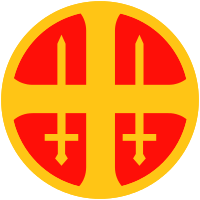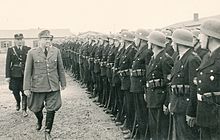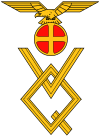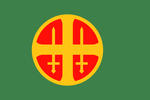


The insignia of the Hirden
| |
 Vidkun Quisling and Oliver Møystad inspecting Rikshirden. | |
| Organization overview | |
|---|---|
| Formed | 1940 |
| Dissolved | 1945 |
| Type | Paramilitary |
| Jurisdiction | German-occupied Norway |
| Headquarters | Hirdens hus, Oslo |
| Parent organization | Nasjonal Samling |
|
Norway and World War II
| |
|---|---|
| Key events |
|
| People |
|
| Organizations |
|
Hirden[1] (the hird) was a uniformed paramilitary organisation during the occupation of Norway by Nazi Germany, modelled the same way as the German Sturmabteilungen.[2]
Vidkun Quisling's fascist party Nasjonal Samling frequently used words and symbols from the old Norse Viking era. During the Second World War, membership was compulsory for all Nasjonal Samling members. In total, about 8,500 Norwegians were members of Hirden during the war. The organisation was dissolved after the liberation, and many of its former members were prosecuted and convicted for treason and collaboration.
During the German occupation Hirden got a more military slant. The intention was that it should form the nucleus of a future Norwegian Nazi army, and a "hirdmarine" (Hirden navy)[3] and a "Hirdens flykorps"(Hirden's air force corps)[4] were created in 1942 in addition to the real Hirden, Rikshirden. However, many Hirden members volunteered to Norwegian military units in the war on Nazi German side or served as guards in the various prison camps. Hirden had a broad mandate to conduct operations against dissidents, independent of all police authorities, many of which included the use of violence.[5]
A 2014 Dagsavisen article said that "8 of 10" prisoners "died in the prison camps where Hirden performed guard duty under the leadership of SS".[6]
| Insignia | Flag | Name | Period | Description |
|---|---|---|---|---|

|

|
Rikshirden (transl. National Hirden or Hirden of the realm) |
1933–1945 | Rikshirden is the most important Hirden organisation and usually the one referred to by just "Hirden". Rikshirdenwas responsible for ensuring the security of NS party members and Quisling regime officials. |
| Hirdvaktbataljonen (transl. Hirden Guard Battalion) |
1942–1943 | Shortlived Hirden branch which primarily served guard duty at prison lairs, including foreign prisons. After the branch was dissolved, many of the members joined SS-vaktbatalijon (SS Guard battalion). | ||

|
Førergarde (transl. Leader guard) |
1942–1945 | The personal guards of the party leader (fører); Vidkun Quisling. The guard was made up of 150 handpicked voluntary recruits. They served much the same purpose as the former Royal Guards. | |

|
Hirdens Flykorps (transl. Hirden Air Force Corps) |
1942–1945 | Hirdens Flykorps was meant to form the basis for a future Norwegian air force. Most members eventually joined the German Luftwaffe. The fleet was rather basic, only featuring some primary glider aircraft. | |

|

|
Hirdmarinen (transl. Hirden Navy) |
1942–1945 | Hirdmarinen was meant to form the basis for a future Norwegian navy. Most members eventually joined the German Kriegsmarine. The fleet was small, featuring only a couple small sailboats. |
| Hirdens Alarmenheter (transl. Hirdens Alarm Units) |
1943–1945 | Operated guard duty and helped Statspolitiet as part of the "armed forces of the realm". | ||
| Hirdens Bedriftsvern (transl. Hirdens Corporate Protection) |
1943–1945 | Armed forces supposed to protect industry and state institutions against sabotage. | ||
| Hirdbataljonen (transl. Hirden Battalion) |
1945 | Military mobilization of NS members. |
| Insignia | Flag | Name | Period | Description |
|---|---|---|---|---|

|

|
Kvinnehirden (transl. Womens Hirden) |
1934–1945 | Kvinnehirden was a branch of the NS Kvinneorganisajonen (transl. NS Womens Organisation). Despite being named a Hird, they were not officially part of the proper Hirden and did not serve any military function and instead provided Sanitation, therefore their flags and emblems lacked the swords in the sun cross. |

|

|
Germanic SS Norway | 1941–1945 | Originally called Norges SS (Norways SS). GSSN was formally a subdivision of the Hirden, but very controversial within the NS party due to its close ties to Germany as a de facto branch of Allgemeine SS. |
| Insignia | Flag | Name | Period | Description |
|---|---|---|---|---|

|

|
Unghirden (transl. Youth Hirden) |
1934–1945 | Branch of NS Ungdomsfylking (transl. NS Youth League), intended for boys between 14–18. It was largely modeled after the German Hitler Youth. |

|

|
Guttehirden (transl. Boys Hirden) |
1934–1945 | Branch of NS Youth League, intended for boys between 10–15. |

|

|
Jentehirden / Gjentehirden (transl. Girls Hirden) |
1934–1945 | Branch of NS Youth League, intended for girls between 15–21. |

|

|
Småhirden (transl. Small Hirden) |
1934–1945 | Branch of NS Youth League, intended for girls between 9–15. |

| Insignia | Rank | Translation | Comparative rank in the Wehrmacht |
|---|---|---|---|
| Hirdfører | |||
| Overste hirdsjef | Senior hird chief | ||
| Regimentsfører | Regimental commander | ||
| Nestregimentsfører | Second regimental commander | ||
| Fylkingfører | Wedge leader | ||
| Sveitfører | District leader | ||
| Nestsveitfører | Second district leader | ||
| Troppfører | Troop commander | ||
| Underfører | |||
| Kommandersersjant | Commander sergeant | ||
| Kvartermester | Quartermaster | ||
| Overlagfører | Senior squad leader | ||
| Furer | Leader | ||
| Lagfører | Squad leader | ||
| Mannskap | |||
| Nestlagfører | Second squad leader | ||
| Speider | Scout | ||
| Nestspeider | Second scout | ||
| Hirdmann | Hird man | ||
| Source:[7] | |||
Pål Nygaard - Forsker, senter for profesjonsstudier, HiOA (...) 8 av 10 døde i leirene hvor Hirden sto vakt under ledelse av SS.
|
| |
|---|---|
| Organisation |
|
| History |
|
| Ideology |
|
| Politicians |
|
| Ideologues |
|
| Atrocities and war crimes |
|
| Outside Germany |
(United States) |
| Lists |
|
| Role and impact in German society |
|
| Related topics |
|
|
Ranks, uniforms and insignia of Nazi Germany
| |||||||||||||||||||||
|---|---|---|---|---|---|---|---|---|---|---|---|---|---|---|---|---|---|---|---|---|---|
| Uniforms |
| ||||||||||||||||||||
| Ranks and insignia |
| ||||||||||||||||||||
| Corps colours |
| ||||||||||||||||||||
| Decorations |
| ||||||||||||||||||||
| Flags |
| ||||||||||||||||||||